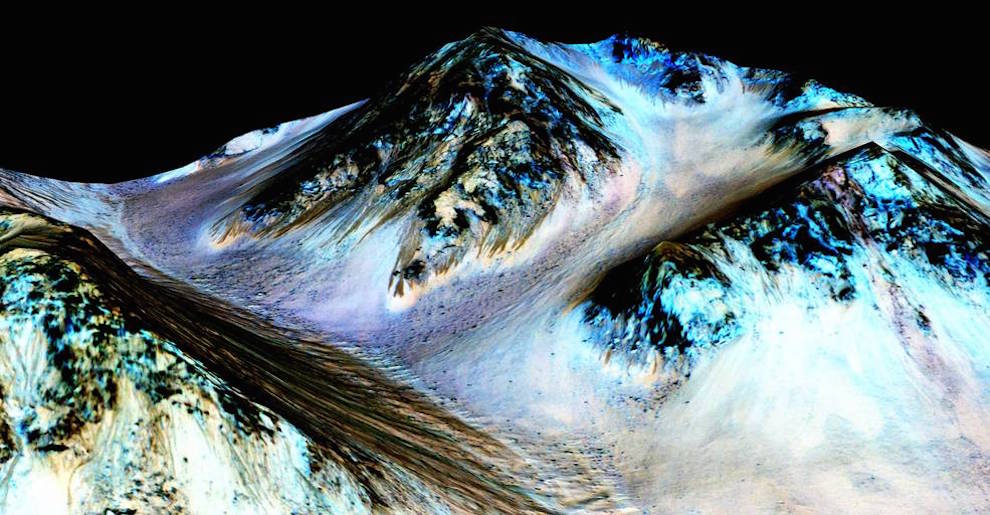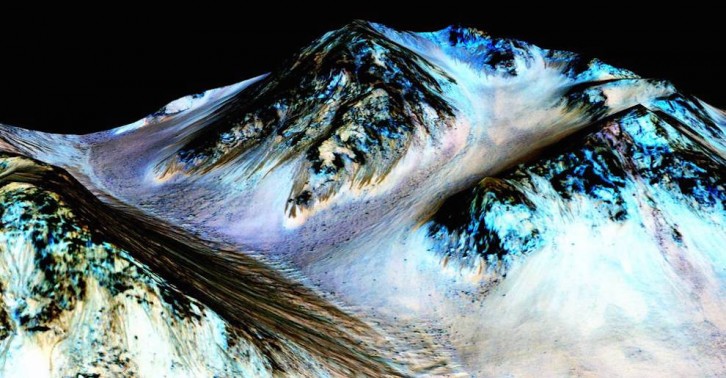Space exploration
Life on Mars is likely ‘just viruses and bacteria’: SMU prof
Professor David Turner says planet's harsh atmosphere is a creature-killer

caption
These dark, narrow, 100 meter-long streaks called recurring slope lineae flowing downhill on Mars are inferred to have been formed by contemporary flowing water.
caption
These dark, narrow, 100 meter-long streaks called recurring slope lineae flowing downhill on Mars are inferred to have been formed by contemporary flowing water.Fearing creatures from the movie Alien actually lurk on the red planet? A professor at Saint Mary’s University says you can sleep soundly.
NASA’s announcement this week that its scientists have found liquid salt water on present-day Mars likely doesn’t mean there are strange creatures on the planet next door.
David Turner, professor emeritus in the astronomy and physics department at Saint Mary’s University says Mars’ low-lying ozone layer likely terminates most forms of life.
“Ozone forms peroxides in the presence of water and both chemical compounds are highly reactive and destructive of simple life forms. So, yes [there is water], but life? Not so clear. I am not terribly optimistic about this,” Turner said in an email. “Don’t go looking for Martians on Mars. Just viruses and bacteria, perhaps.”
The study was published in the journal Nature Geoscience on Monday.
“The existence of liquid water, even if it’s super salty briny water, gives the possibility that if there is life on Mars, we have a way to describe how it might survive,” said John Grunsfeld, former astronaut and NASA’s associate administrator for science, during a press conference announcing the discovery. “We are now at a point, technologically, that we have the capability to go [to Mars], ask this question of ‘is there life on Mars,’ and answer it. This is to me the most exciting thing, that that question is not an abstract scientific question, it is a concrete one that we can answer.”
Scientists first noticed dark streaks in 2010 at various places across the planet that appeared with warm weather and vanished with the cold. Dubbed “recurring slope lineae,” or RSL for short, the streaks looked to be flowing down steep hills.
It was confirmed to be water after the Mars Reconnaissance Orbiter took samples of the areas where RSLs occur and discovered hydrated salts that aren’t present anywhere else on the planet. The salts cause ice to thaw into liquid water, just as road salt does to Earth’s ice.
But don’t start planning your Mars beach vacation just yet. The salty water is more of a wet patch of dirt than a lake or even a puddle.
“This is the planet that’s most like the Earth…if we go back three billion years and take a look at Mars, Mars was a very different planet. It had an extensive atmosphere and in fact what we believe was a huge ocean, perhaps as large as two-thirds of the northern hemisphere,” said Jim Green, director of planetary science at NASA’s Washington headquarters, at the press conference. “But something happened. Mars suffered a major climate change and lost its surface water.”
Mars has two polar ice caps and ice was discovered on other parts of the planet in the early 2000s. The discovery of liquid water suggests that it would be possible for life to exist on Mars today, said Grunsfeld.
Following Monday’s announcement, many Twitter users speculated that the discovery of water could be linked to aliens.
Alien presence or not, NASA continues to investigate the red planet and beyond, and plans to send humans to Mars sometime in the 2030s.
“We are on a journey to Mars and science is leading the way…[Mars] will provide us with a great sense of our place in the universe and our solar system in particular,” said Grunsfeld. “Please stay tuned to science, because science never sleeps.”

